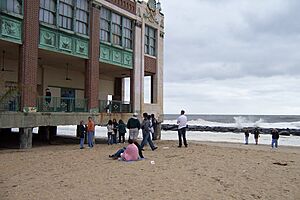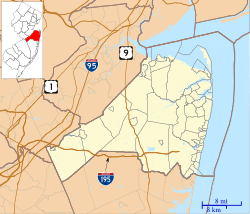Asbury Park Convention Hall facts for kids
 |
|
| Address | 1300 Ocean Avenue |
|---|---|
| Location | Asbury Park, New Jersey |
| Public transit | NJ Transit North Jersey Coast Line
|
|
Asbury Park Convention Hall
|
|
| Location | Ocean Avenue, Asbury Park, New Jersey |
| NRHP reference No. | 79001512 |
| Significant dates | |
| Added to NRHP | March 2, 1979 |
| Owner | City of Asbury Park |
| Type | Convention hall |
| Capacity | 3,600 |
| Opened | 1925 |
| Tenants | |
| New Jersey ShoreCats (USBL) (1998–2000) Jersey Shore Roller Girls (WFTDA) (2008–present) |
|
The Asbury Park Convention Hall is a large building in Asbury Park, New Jersey. It sits right on the boardwalk next to the Atlantic Ocean. This hall can hold 3,600 people and is used for many different events. You can see sports, concerts, and special shows here.
It was built between 1928 and 1930. Right next to it is the Paramount Theatre. Both buildings are connected by a beautiful area called the Grand Arcade. The Convention Hall and Paramount Theatre are important historical places. They are listed on the National Register of Historic Places.
Contents
Building History
In 1916, the mayor of Asbury Park, Clarence E.F. Hetrick, wanted a big convention center. He hired famous architects to design a building that could hold 5,000 people. However, the land he wanted was owned by the city's founder, James A. Bradley, who would not sell it.
Later, in 1927, a fire destroyed another building on the boardwalk. After this, people voted to build a new convention center on that spot. Mayor Hetrick then hired architects Warren and Wetmore. This firm also designed the famous Grand Central Terminal in New York City.
Their design included a 1,600-seat theater. This theater was connected to an enclosed arcade that went over the boardwalk. The arcade then led to the main Convention Hall. This hall had 60,000 square feet of space for shows and events. A large part of the hall stretched 215 feet over the beach and water. It was supported by strong concrete pillars. For many years, visitors could look directly at the ocean from the hall's walkways. The whole complex was designed in a mix of Italian and French styles. It also had many nautical (ocean-themed) decorations because of its location.
WCAP Radio Station
In 1927, a radio station called WDWM moved to Asbury Park. It changed its name to WCAP, which stood for "Wonder City of Asbury Park." In 1931, the station moved its studios into Convention Hall. The architects had made sure the hall was ready for radio broadcasts.
This allowed WCAP to broadcast live music and performances from the hall. Bands like the Arthur Pryor Band played live on the radio. The station stayed in Convention Hall until 1944. Today, the station is called WJLK and still broadcasts from a nearby town.
The Morro Castle Ship Disaster
On September 8, 1934, a cruise ship called the SS Morro Castle caught fire. The ship was returning to New York from Havana. After the fire, the ship could not move on its own. The Coast Guard tried to tow it, but strong waves broke the tow lines.
The burning ship then drifted towards the shore. A radio announcer from WCAP, Tom Burley, was broadcasting from Convention Hall. He saw the burning ship getting closer to the beach. He famously announced on air, "She's here! The Morro Castle is coming right toward our studio!"
The ship eventually stopped on a sandbar right in front of Convention Hall. Its back end was facing the hall's oceanfront walkway. The next morning, people used ropes and a special device called a breeches buoy to get onto the ship. They searched for survivors and anything valuable. Sadly, 137 people died in the disaster.
The Morro Castle stayed on the sandbar for months. Many curious people came to Asbury Park to see the burnt ship. This helped the city's economy during the Great Depression. In March 1935, the ship was finally towed away to be taken apart.
The Pipe Organ
Convention Hall was designed to have a huge Wurlitzer Pipe Organ. The architects placed special grilles in the walls to cover the organ's pipes. This design used the hall's great sound to make the organ sound even bigger.
Because of the Great Depression, the city couldn't buy the Wurlitzer. Instead, they bought a smaller organ from the Earl Carroll Theatre in New York City. This organ was built by George Kilgen & Sons. Even though it was smaller, it sounded very powerful in the hall.
In the 1930s, Asbury Park hired a special organist to play free concerts for visitors. WCAP radio even broadcast some of these concerts. The organ was played regularly until 1984. Volunteers later worked to fix up the organ and add more pipes. They also made the organ's keyboard movable so players could be closer to the audience. This Kilgen organ is one of only two left in New Jersey.
Events and Gatherings
The first big event at Convention Hall was a meeting of the New York Friars' Club in 1930. Since then, the hall has hosted many different types of gatherings. These include conventions, community meetings, and trade shows. It has also been home to antique car shows.
Since 1951, the Monmouth County Cotillion Society has held its yearly Debutante Ball here. The hall is also used for Asbury Park's Easter Parade if the weather is bad. Since 2008, the Jersey Shore Roller Girls roller derby team has played their home games at Convention Hall.
Concerts and Music

Rock and roll music has been a big part of Convention Hall since the 1950s. In 1956, a concert by Frankie Lymon & The Teenagers had some trouble. The mayor even thought about banning rock and roll shows, but it never happened.
In the 1960s and 1970s, many famous bands played here. These included Ike & Tina Turner, Black Sabbath, The Beach Boys, James Brown, The Doors, Janis Joplin, KISS, The Rolling Stones, and Pink Floyd. Led Zeppelin even played at Convention Hall in 1969, instead of going to Woodstock.
The hall also hosted one of the last concerts by the original Lynyrd Skynyrd band in 1977. Sadly, their tour plane crashed a few months later. Through the 1970s, 80s, and 90s, more big names played at the hall. These included The Allman Brothers Band, Judas Priest, Iron Maiden, Van Halen, The Clash, and No Doubt.
Since the late 1990s, Bruce Springsteen has had a special connection with Convention Hall. He often rehearsed for his tours there. Fans would gather outside to hear what new songs he might play. He also held special holiday shows. The large sign on top of Convention Hall even says "Greetings from Asbury Park." This is a nod to Springsteen's first album, Greetings from Asbury Park, N.J.
In the 2000s, many other popular bands played at the hall. Some of these were Bob Dylan, Deftones, Incubus, Slipknot, Pantera, Disturbed, 50 Cent, and Dream Theater.
Images for kids












